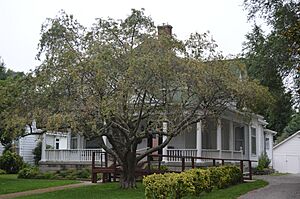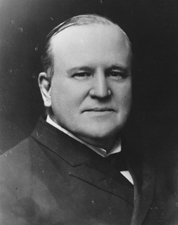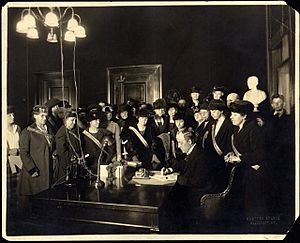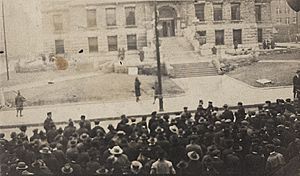Edwin P. Morrow facts for kids
Quick facts for kids
Edwin P. Morrow
|
|
|---|---|
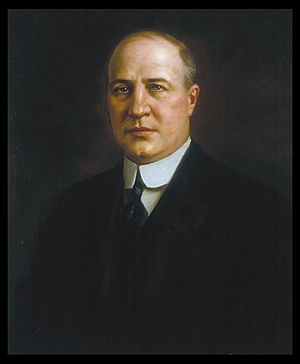 |
|
| 40th Governor of Kentucky | |
| In office December 9, 1919 – December 11, 1923 |
|
| Lieutenant | Thruston Ballard |
| Preceded by | James D. Black |
| Succeeded by | William J. Fields |
| U.S. District Attorney for the Eastern District of Kentucky | |
| In office 1910–1913 |
|
| Appointed by | William Howard Taft |
| Personal details | |
| Born | November 28, 1877 Somerset, Kentucky |
| Died | June 15, 1935 (aged 57) Frankfort, Kentucky |
| Resting place | Frankfort Cemetery |
| Political party | Republican |
| Spouse | Katherine Hale Waddle |
| Relations | Son of Thomas Z. Morrow Nephew of William O. Bradley |
| Alma mater | University of Cincinnati Law School |
| Profession | Lawyer |
| Signature | |
| Military service | |
| Branch/service | U.S. Army |
| Years of service | 1898–1899 |
| Rank | Second lieutenant |
| Unit | 4th Kentucky Infantry Regiment |
| Battles/wars | Spanish–American War |
Edwin Porch Morrow (November 28, 1877 – June 15, 1935) was an American politician. He served as the 40th Governor of Kentucky from 1919 to 1923. He was the only Republican elected to this office between 1907 and 1927. Morrow believed in equal rights for African-Americans and worked to stop violence. His family was very involved in the Republican Party in Kentucky. His father and uncle were also important figures in the party.
After serving in the Spanish–American War, Morrow became a lawyer. He was appointed a U.S. District Attorney in 1910. In 1915, he ran for governor but lost by a very small number of votes. He ran again in 1919 and won by a large margin. As governor, he passed laws to prevent violence and improve education. He also worked to reorganize the state government. After his term, he served on national railroad boards. He never held elected office again.
Contents
Early Life and Education
Edwin Morrow was born in Somerset, Kentucky, on November 28, 1877. He had a twin brother, Charles. His father, Thomas Z. Morrow, helped start the Republican Party in Kentucky. His uncle, William O. Bradley, became Kentucky's first Republican governor in 1895.
Edwin went to public schools in Somerset. At age 14, he attended St. Mary's College. He later went to Cumberland College (now the University of the Cumberlands). There, he was a strong debater and played football and baseball.
In 1898, Morrow joined the 4th Kentucky Infantry Regiment for the Spanish–American War. He did not see active combat because he became sick with typhoid fever. He left the service as a second lieutenant in 1899. In 1900, he began studying law at the University of Cincinnati Law School. He earned his law degree in 1902.
Morrow started his law practice in Lexington. One of his first cases made him well-known. He defended a man accused of murder. Morrow proved that the man's confession was forced. He also showed that other evidence against his client was false. The man was found not guilty in 1902.
In 1903, Morrow moved back to Somerset. He married Katherine Hale Waddle there on June 18, 1903. They had two children, Edwina Haskell and Charles Robert.
Political Career
In 1904, Morrow became the city attorney for Somerset. He served in this role until 1908. In 1910, President William Howard Taft appointed him U.S. District Attorney for the Eastern District of Kentucky. He held this job until 1913.
Morrow's first political experience was helping his uncle, William O. Bradley, in his campaign for governor in 1895. In 1912, Morrow was chosen as the Republican candidate for a U.S. Senate seat. However, he lost the election because the state legislature had many more Democrats. This was the last time the Kentucky legislature would elect a senator. After this, people voted directly for senators.
In 1915, Morrow ran for governor as the Republican candidate. His opponent was his good friend, Augustus O. Stanley. Morrow spoke out against corruption in the government. Both candidates supported new ideas for progress. Stanley won the election by only 471 votes. This was the closest governor's race in Kentucky's history. Even though it was very close, Morrow chose not to challenge the results. This made him very popular with the public.
Governor of Kentucky
Morrow was a delegate to the Republican National Convention in 1916, 1920, and 1928. In 1919, he was again chosen as his party's candidate for governor. His opponent was James D. Black. Black had become governor earlier that year when Stanley resigned.
Morrow won the election by more than 40,000 votes. This was the biggest win for a Republican governor in Kentucky's history at that time.
As governor, Morrow made many changes to the state government. He replaced some boards with nonpartisan groups. He also improved how highways were managed and changed property taxes. He worked to improve the education system. This included better ways to choose textbooks. He also put a tax on racetracks to help pay for teachers' salaries. Morrow also wanted to make the judiciary (court system) nonpartisan, but this idea did not pass.
Morrow strongly supported enforcing laws against carrying hidden weapons. He also limited the activities of the Ku Klux Klan. He was an active member of a group called the Commission on Interracial Cooperation. This group worked to stop racial violence in the South.
Morrow gained national attention for stopping a mob from harming a Black prisoner in 1920. He was not afraid to remove local officials who did not prevent or stop mob violence.
In 1922, Democrats gained more control in the state legislature. This made it harder for Morrow to pass his ideas into law during the second half of his term. He asked for money to improve state highways and for laws to give women equal rights. He also suggested selling bonds to pay for improvements to universities, schools, prisons, and hospitals. However, most of his ideas were voted down.
Morrow could not run for a second term as governor because of the state constitution. His achievements were not enough to help the next Republican candidate win the governor's election in 1923.
Later Career and Death
After being governor, Morrow moved back to Somerset. He became active in the Watchmen of the Republic. This group worked to end prejudice and promote understanding. He served on the United States Railroad Labor Board from 1923 to 1926. He then served on the Railway Mediation Board from 1926 to 1934.
In 1934, he left his board position to run for a seat in the U.S. House of Representatives. However, he did not win his party's nomination.
After this, Morrow planned to return to his law practice in Lexington. On June 15, 1935, he died suddenly of a heart attack. He was staying with a cousin in Frankfort at the time. He is buried in Frankfort Cemetery.
Images for kids


